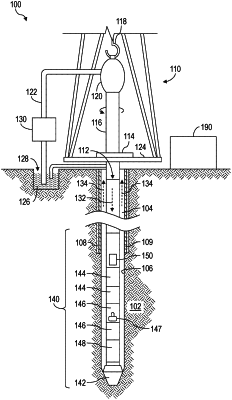| CPC E21B 41/00 (2013.01) [G01V 99/005 (2013.01); G06F 11/004 (2013.01); G06F 16/355 (2019.01); G06N 20/00 (2019.01); G06Q 10/06 (2013.01); E21B 49/00 (2013.01)] | 20 Claims |

|
1. A method comprising:
using machine learning for sedimentary facies prediction based on one or more logs acquired in a borehole, by performing, via one or more processors of a computing system:
data management comprising:
depth matching or resampling, comprising:
depth-shifting measurement logs against a gamma ray (GR) or other reference log; and
depth-matching core facies descriptions by comparing a core GR to the GR log or the other reference log or using image logs;
data normalization and outlier handling, comprising:
normalizing well logs or calculated curves; and
collapsing a predetermined percentile of outliers into first and last categories or bins of the normalized well logs or calculated curves;
missing data handling comprising:
discarding absent values representing less than a predetermined percentage of data; and
reconstructing a petrophysical log from other petrophysical measurements using one or more supervised learning algorithms or via computation using empirical equations; and
balanced data set distribution comprising correcting unbalanced data using weighted averaging;
a petrophysical clustering of borehole depths, wherein the borehole depths are gathered into clusters based on similarities in the one or more logs using an unsupervised learning technique, wherein the one or more logs represent formation characteristics versus depth, and wherein the data management is performed before the petrophysical clustering;
a log inclusion optimization, including a selection of one or more parameters of the petrophysical clustering using a supervised learning technique, wherein the one or more parameters include a number and type of considered logs among the one or more logs and a clustering method that clusters best against core depositional facies; and
a classification of the clusters into the core depositional facies using one or more predetermined rules.
|